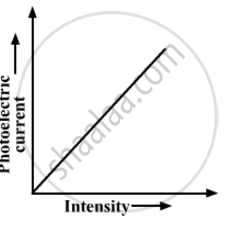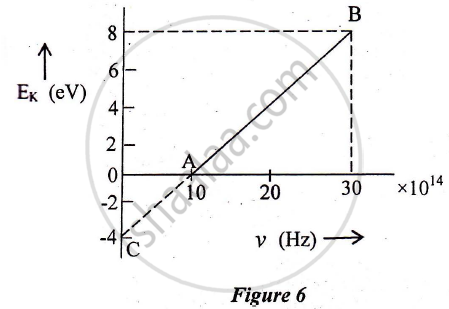Advertisements
Advertisements
Question
Draw a plot showing the variation of photoelectric current versus the intensity of incident radiation on a given photosensitive surface.
Solution

APPEARS IN
RELATED QUESTIONS
The photoelectric current in a photoelectric cell can be reduced to zero by a stopping potential of 1.8 volt. Monochromatic light of wavelength 2200Å is incident on the cathode. Find the maximum kinetic energy of the photoelectrons in joules. [Charge on electron = 1.6 x 10-19 C]
Light of intensity ‘I’ and frequency ‘v’ is incident on a photosensitive surface and causes photoelectric emission. What will be the effect on anode current when the anode potential is increased? In each case, all other factors remain the same. Explain, giving justification in each case.
Two monochromatic beams, one red and the other blue, have the same intensity. In which case (i) the number of photons per unit area per second is larger, (ii) the maximum kinetic energy of the photoelectrons is more? Justify your answer.
If the total energy of radiation of frequency 1014 Hz is 6.63 J, calculate the number of photons in the radiation. (Planck’s constant = 6.63 x 10–34 J.s.)
In an experiment of the photoelectric effect, the graph of maximum kinetic energy EK of the emitted photoelectrons versus the frequency v of the incident light is a straight line AB shown in Figure 6 below:

Find:
1) Threshold frequency of the metal
2) The work function of the metal.
3) Stopping potential for the photoelectrons emitted by the light of frequency `v = 30 xx 10^14 Hz`
In photoelectric effect, why should the photoelectric current increase as the intensity of monochromatic radiation incident on a photosensitive surface is increased? Explain.
What is photoelectri effect ? Defin (i) Stopping potential (ii) Photoelectric work function.
Calculate the momentum of a photon of energy 6 x I 0-19 J.
With reference to the photoelectric effect, what is meant by threshold wavelength?
If the frequency of the incident radiation is increased from 4 × 1015 Hz to 8 × 1015 Hz, by how much will the stopping potential for a given photosensitive surface go up?
